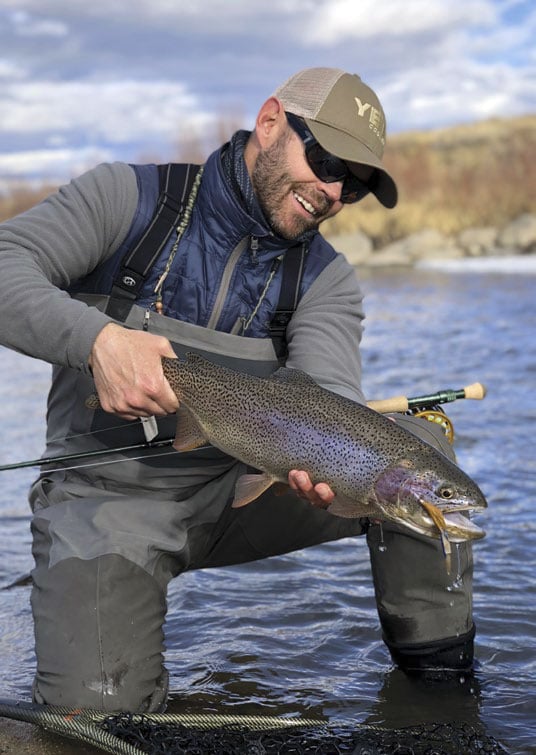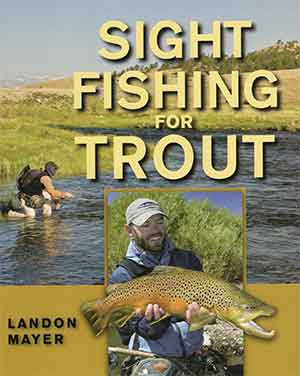Rigging Streamers for Trout Fishing

Notice the streamer hanging out of this rainbow’s mouth. In my opinion, the Barr’s Meat Whistle is one of the most versatile patterns on the market today. Jack Drees photp
Leader and Tippet Selection
While fishing streamers you can use heavy leaders and tippets that prevent the trout from breaking off before the knot pulls loose. I got this advice from my good friend John Barr. I was using 3X for streamers, but John said, “If the fish is willing to commit to taking a streamer on 3X fluorocarbon, it will not shy away from a streamer on 0X fluorocarbon. This will stop break-offs and let you land a majority of the trout you hook.” Boy, was he right! I now use nothing but 0X leaders and tippets for streamers, and I hook and land more fish.
If you are fishing a sink-tip line, use a shorter leader so that the fly stays close to the river bot- tom. For floating lines, use a longer leader so that the flies can sink to where the trout are holding. I prefer to use a longer leader when fishing streamers, whether I have a sinking or floating line, so that the trout have less chance of detecting my fly line. For sinking lines, I use 7- or 8-foot leaders, and for floating lines, 8- to 11-foot leaders. I am a fan of building streamer leaders starting with a blood knot connecting a 3-foot section of 25-pound fluorocarbon, or Maxima Ultra Green, connected to another 3 feet of 20-pound flouro, or Maxima, lastly connected to a 3- to 5-foot piece of fluorocarbon. Not only does this help turn over the leader, but the heavy fluorocarbon tippet sinks fast, like a sink-tip fly line. I have more versatility and can place the fly or flies above the trout without spooking the target. Knots The first step in rigging for streamers starts with a powerful knot, capable of holding without pulling loose. Light tippet material will break before the have more versatility and can place the fly or flies above the trout without spooking the target.
Knots
The first step in rigging for streamers starts with a powerful knot, capable of holding without pulling loose. Light tippet material will break before the knot pulls loose. In streamer situations, you want material that is so strong that the first thing to give will be the knot. A correctly tied knot can keep the trout you have on until the fish is in the net. When I first started fly fishing, I learned the clinch knot for tying on dry flies and nymphs with light tippets, ranging from 4X to 6X. I learned that this knot has less bulk on the eye of the hook, and is strong enough to hold the trout. Flies look more natural as they drift downstream. This has worked well on light tippets, but leads to disaster using heavy materials. The knot pulls loose with heavy tippets and leaders because the material cannot cinch properly. The solution is the improved clinch knot; it is easy to tie and can mean the difference between landing a trophy trout or watching the fish get away.
The non-slip loop knot allows the streamer to dance up, down, and side-to-side while it drifts or is stripped through a run. This can be incredibly helpful when you are trying to provoke a trout to hit your fly.
Swivels and Snaps
We have all been there when you pick the fly up from the water and it spins like a twisted rubber band. Not only does this weaken the leader, but it prevents the best presentation. Instead use 1 to 3 feet of 20 to 25-pound fluorocarbon, or Maxima Ultra Green, from the fly line with a double nail knot to a #10 Sampo Raven micro swivel using an improved clinch knot. From the swivel attach a 3-foot piece of 13 to 15-pound fluorocarbon, or Maxima, using an improved clinch knot, and attach the streamer at the opposite end with a loop knot or snap. Not only will this eliminate any twisting, but it will also prevent losing the whole leader if you snag because the lighter tippet will break at the hinge point of the swivel.
Fly Selection
With the many variations of streamers and buggers on the market today, narrowing down your selection can be difficult. Large, unconventional looking streamers are more effective when trout are making predatory attacks on the flies. In situations when the trout are eating injured baitfish or relying on a food source like small fry or escaping crayfish, a more realistic size and slim-bodied look is best. Have a selection of both so that you are prepared. This is especially helpful in clear water when you see the trout to which you are presenting the fly. The fish will not move far to take the streamer in clear water, and when there are bluebird skies with no security from above, the fish feeding lanes.
Picking the correct streamer imitation starts with reading the trout’s behavior. If trout are aggressive, attractor patterns are ideal. When fish are selective, a natural imitation with a slim profile is best. Try different flies and read the behavior of the fish.

A baby brown and a fly that does a good job of imitating it. To select a quality streamer that looks natural to the trout, get it wet to see how the fly and profile look in the water.
I always simplify my fly selection based on what food source is in the water. For example, if there are a lot of brown-trout fry in the river, I choose a rust or tan pattern. This natural imitation is ideal in steady, slow, clear water because the trout are looking for the natural food sources. If flows increase the day before you head up to the river, it will stain the water and deepen areas that were shallow. Your ability to see the fish prefer to wait for injured prey to drift into their will be compromised, and so is the trout’s ability to see you. These conditions warrant a change to brighter, more attractive streamers with flash to get the trout’s attention.
There are two basic types of streamers: attractors with flashy materials intended to get the trout’s attention, and natural imitations resembling the slim profile of a baitfish, sculpin, or other prey. The attractor patterns are effective when fish are preparing to spawn and are aggressively guarding water, or in deep, warm water when the trout are more active and can move without the threat of predators from above. This is some of the most exiting sight fishing: when you watch a trout race off to annihilate a large, bright streamer in clear water, it makes the hair on the back of your neck stand up.
I prefer high water, prespawn timing, and warm conditions when I sight-fish with attractor streamers. These are the best times to get aggressive takes because the trout are more active in these conditions than at any other time of year. You immediately know if the trout are looking for a big meal after the first cast and retrieve. If you don’t get even a look from the fish you have spotted, consider using a more natural imitation.
To select the right attractor, determine the main food supply in the water. For example, if you are fishing a large river in Montana with an abundance of sculpin, your fly should imitate the natural food source—something like Mike Lawson’s Conehead Sculpin with the addition of flash, Sili Legs, or materials added to attract the fish. On the other hand, if you are fishing fair-sized tailwaters with a huge supply of crayfish, imitate and match the color of the natural food source (while adding attracting materials to it), like John Barr’s Meat Whistle.
When the trout are less aggressive, lethargic, or are holding in shallow water with less cover, use a streamer with less flash that imitates a natural food source. The trout may not move far when they are lethargic. The less movement the trout makes, the better its chances for survival are. With a more natural-looking fly and a slower retrieve, the trout can consume the meal without expending too much energy.
I use more natural-looking flies in winter, early spring, late fall, in clear or shallow water, and for any wary fish. If you do decide to go with the realistic fly, be sure to allow long pauses with every retrieve so that the trout, if it chooses to follow the fly, has a chance to eat it as it drifts.
Profile is important when selecting streamers. The Woolly Bugger, which is a great fly used worldwide for many different species of fish, elicits a reaction-based strike. When you stop the fly in the water, the hackle fibers stick out to the side; during the pause, it gets a fish’s attention. However, this can also have the opposite effect on trout you can see, and in cooler water where trout are less active, because the fly does not look like a baitfish. That is when you need a slim-profile fly, which allows you to do more in the retrieve by manipulating the fly. A slim body and profile is why many successful flies, like the Slump Buster, Mayer’s Mini Leech, and Clouser Minnow, don’t stay in the fly bins. They work in some of the world’s most pressured waters.
Double Streamers
When you are sight fishing with streamers, you can add a second fly to give the fish more options of color, size, and shape. I refer to these two-fly setups as double-trouble rigs.
My favorite double streamer setup is the “double slump.” I use different colors and sizes of John Barr’s streamer, the Slump Buster: the lead fly is a #4; and eighteen inches below that, the trailing fly is a #6. I keep the sizes the same and change the colors—my golden ticket for rivers all over the United States.

Double slump rig. Fishing two streamers allows you to get deep into the river, to trout you cannot see. Use tungsten cones, lead eyes, or lead wrap on two flies to increase the weight of your rig. If there is too much weight, adjust by using an unweighted fly.
You can mix an attractor and a natural imitation. I keep my lead fly a natural imitation with a slightly brighter appeal. My favorite fly for this is Mike Lawson’s Conehead Wool Sculpin in tan. It’s a great fly to use when you want to see the fly as you are stripping it through the water or drifting it to the trout. From the back of the sculpin, trail something bright, big, and ugly—like a Dirty Hippie. That way you will know if the trout is more likely to take an attractor streamer or the natural imitation, located eighteen inches above.
If you really want to get the trout’s attention, put a food source imitation above the streamer to make it look like a small fry chasing a meal. I think trout look at this as competition, and a double food source triggers strikes. To determine what fly to place above the streamer, match it to the food supply that is prevalent in the water. For example, in the summer, the browns consider stoneflies in the water an easy meal.












